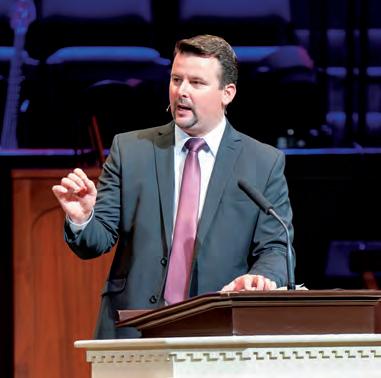








































































Montgomery Botanical Gardens Pottery Class
Dinner Recipe: Leftover Thanksgiving Turkey Pot Pie
Grumpy But Grateful
Event: Mania: The ABBA Tribute at MPAC
Event: Folds of Honor Golf Tournament
Event: Christmas Fabric Bag Making Class
Event: Masterworks II: Evening with Tobias Picker
Event: St. Johns Church Annual Bazaar
Event: Miracle at Hilltop Public House
Caregiver of the Month
Word Search Contest
Moore Wealth Management


Founder Jim Watson (1950-2024)
Publisher Jason Watson 334.328.5189 cell/text jason@riverregionboom.com
Editor DeAnne Watson 334.462.0225 cell/text
Contributing Writers
Jeff Barganier
Greg Budell
Susan Moore
Rebecca Oates
Nick Thomas
Cover Photography
Photography by DiAnna Paulk photographybydiannapaulk.com
Advertising
Jason Watson, 334.328.5189 jason@riverregionboom.com



November has a funny way of sneaking up on us. One minute we’re sweating through early fall football games, and the next we’re Googling “how to thaw a turkey” and wondering where we stashed the good tablecloth (and if the cranberry stain from 2019 still counts as “vintage”).
This month’s BOOM! is a reminder that life, like Thanksgiving dinner, doesn’t have to be picture-perfect to be beautiful.
At the heart of this issue is our cover profile, Kim Mason—a woman who’s living proof that reinvention, adventure, and joy aren’t reserved for the young. Whether she’s managing financial portfolios, directing community theater, learning to play the standup bass, or saying yes to love again at 61, Kim embodies what it means to age with courage, creativity, and purpose. Her story is a gift—and one that’ll make you want to chase your own next chapter.
Of course, it wouldn’t be November without a few extra helpings of chaos, carbs, and comedy. Our Grumpy But Grateful column is back with a Turkey Day Trouble edition that exposes the truth about Pinterest-perfect holidays—and celebrates the messy, gravy-drenched joy of the real thing. (If you’ve ever zip-tied a booster seat to a barstool, this one’s for you.)
Speaking of real, Greg Budell takes a hilarious stab at holiday weight gain—breaking down everything from the Cabbage Soup Diet to Ozempic Bank Account Syndrome. His advice? Skip the fads. Laugh more. Move your body. And maybe save room for pie.
And if all the togetherness has you needing some space, we’ve got you covered with two outdoor features: Nick Thomas explores Tuscaloosa’s scenic Riverwalk, and Jeff Barganier takes us back to the historic Fryemont Inn, where family, faith, and fireplace memories linger like the scent of mountain wood smoke.
You’ll also find practical wisdom in this month’s piece on navigating adult children’s parenting styles—because it turns out “parenting as a verb” looks a little different in 2025, and learning to love without overstepping is a skill we’re all still refining.
As always, our goal is to celebrate the journey of aging—not as a slow fade, but as a vivid, ever-evolving story. From the road trips to the recipe flops, from rediscovering confidence to writing letters that become family traditions, this issue reminds us: life is full, even when it’s full of lumps.
So here’s to a month of giving thanks—
For messy tables and mismatched chairs. For new dreams and old recipes.
For friends who become family, and families that somehow hold together.
And for every gravy-stained moment that reminds us what really matters.
Wishing you a November filled with warmth, wonder, and a bit of whipped cream on top.
And as always, Age Well—



On a gorgeous, cool Saturday morning in October, the Montgomery Botanical Gardens provided a delightful Pottery Class led by Mrs. Sara Crocker. Cathy Maddox, President of the MBG Board of Directors, welcomed the attendees to the MBG Wisdom Wood Outdoor Classroom and briefly talked about the gardens. Maggie Stringer, Chair of the MBG Education Committee, introduced Mrs. Crocker, who is an Alabama-based ceramic artist. She taught the class and demonstrated how to work with clay. Her functional pottery collections focus on emulating the natural world through color and texture. She strives to bring a moment of beauty to everyday routines with her pieces. Ms. Crocker has taught pottery since 2021 and is currently the ceramics teacher at the Montgomery Academy. She sells her work locally at Southern Art and Makers Collective, the Montgomery

Museum of Fine Arts Gift shop, and a variety of pop-up markets in the river region.

Class attendees learned how to create air-dry clay flowers. Sara demonstrated several types of flowers and the techniques needed to make them. She discussed working with a variety of types of clay and using items from nature to create texture in the pieces. Students were given the opportunity to create their own clay flowers, and many produced lovely examples.

After the class, some of the attendees strolled through the Phase I Southern Garden to enjoy the beautiful fall blooms and observe the busy pollinators at work. Then they visited the Japanese Maple Garden and Hosta Garden of Phase II and viewed the construction in progress for the new MBG Pedestrian Entrance on Forest Avenue.
There was no admission fee to the gardens, and there was no charge for this class, but all donations are sincerely appreciated. The final class in the gardens for 2025 will be on November 8, 2025, and the topic will be “How to Create Holiday Decorations Using Natural Materials”. So put it on your calendar. Please consider becoming a member of MBG to support the continued development and maintenance of the gardens. Membership dues for 2026 may be paid from October through December. There are always signs in the gardens displaying the MBG QR code that may be used to make a donation to support the gardens. Or you may visit the MBG website to donate at www. montgomerybotanicalgardens.com, or you may mail your donation to Montgomery Botanical Gardens, P.O. Box 344, Montgomery, Alabama 36106.

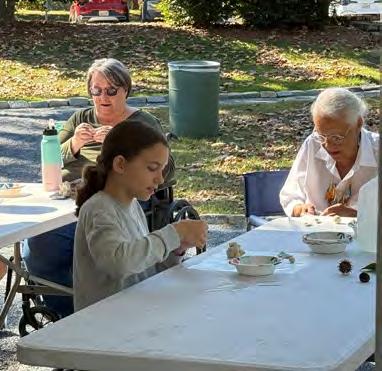

Ingredients:
2 tablespoons unsalted butter
2 cloves garlic, minced
1 small onion, diced
⅔ cup frozen corn kernels
½ cup frozen diced carrots
½ cup frozen peas
⅓ cup all-purpose flour
1 cup chicken broth
¾ cup milk
1 teaspoon fresh thyme leaves
Kosher salt and freshly ground black pepper
2 cups chopped leftover Thanksgiving turkey
1 puff pastry sheet, cut into four
4 1/4- inch squares
1 large egg, beaten
Instructions:
Preheat oven to 375 degrees F. Lightly oil four 10-ounce ramekins or coat with nonstick spray.
To make the filling, melt butter in a large skillet over medium high heat. Add garlic, onion, corn, carrots and peas and cook, stirring occasionally, until onions become translucent, about 2 minutes. Whisk in flour until lightly browned, about 1 minute. Gradually whisk in chicken broth, milk and thyme, and cook, whisking constantly, until slightly thickened, about 1-2 minutes. Stir in turkey; season with salt and pepper, to taste.
Divide the filling evenly into the ramekins. Top with puff pastry and gently cut 4 vents in the top of the crust. Brush each crust with the beaten egg. Place into oven and bake until the crust is golden brown, about 20 minutes.






There’s good news for Alabamians living with limited income and resources. The Medicare Extra Help program—also known as LIS—expanded in 2025. If your income is below 150% of the federal poverty level, you may now qualify for full Extra Help benefits.
This means you could pay lower or no premiums, reduced Part D drug copays and reduced or no Part D deductible for your prescriptions. Many people don’t realize they’re eligible—so it’s worth checking.
For example, in 2025, individuals earning less than $23,475 per year (or couples earning less than $31,725 per year) may qualify as long as your assets are below the specified limits. You could save hundreds of dollars each year on the medications you rely on!
To see if you qualify for Extra Help, call: The Social Security Administration at 1-800-772-1213, between 8 a.m. and 7 p.m., Monday through Friday. TTY users should call 1-800-325-0778.
Medicare can be complex, and it’s normal to feel uncertain with so many parts and plans to consider. Blue Cross and Blue Shield of Alabama understands this and offers Medicare plans grounded in decades of experience and trust. For generations, Blue Cross has been a steady partner for individuals and families, providing coverage that gives you confidence and peace of mind as you navigate your healthcare choices. With a name you can depend on, you can feel secure making important decisions about your health.
Medicare is divided into four parts, each covering specific services:
Part A and Part B are provided through the U.S. government and are referred to as Original Medicare.
Part A Hospital Insurance: Covers inpatient hospital stays, care in a skilled nursing facility, hospice care and some home health care
Part B Medical Insurance: Covers certain doctors’ services, outpatient care, medical supplies and preventive services
Part C and Part D are offered through Medicare-approved private insurance carriers, like Blue Cross and Blue Shield of Alabama.
Part C Medicare Advantage: Includes all benefits and services covered under Original Medicare, and typically includes Medicare prescription drug coverage (Part D) as part of the plan
Part D Prescription Drug Plan: Adds prescription drug coverage to Original Medicare and some Medicare Cost Plans, Medicare Private-Fee-for-Service Plans and Medicare Medical Savings Account Plans
Medicare Supplement (Medigap) Plans are not part of Medicare but help cover gaps in Original Medicare, including hospital and medical deductibles, copays and coinsurance. They do not include prescription drug coverage.
INITIAL ENROLLMENT PERIOD (IEP)
ANNUAL ENROLLMENT PERIOD (AEP)
MEDICARE ADVANTAGE OPEN ENROLLMENT PERIOD (MAOEP)
3 MONTHS AFTER through through
3 MONTHS BEFORE October 15 December 7 January 1 March 31
This is the seven-month window surrounding your 65th birthday when you can first enroll in Original Medicare (Part A and/ or Part B) and additional coverage.
From October 15 through December 7, you can review and make changes to your Medicare coverage, including changing or enrolling in a Medicare Advantage plan or swapping from Medicare Advantage to a Medigap plan.
From January 1 through March 31, if you are enrolled in a Medicare Advantage plan, you can make a one-time election to switch to another Medicare Advantage plan or to Original Medicare. If you enroll in Original Medicare, you may also purchase a Medicare Supplement and/or a Prescription Drug Plan.
SPECIAL ENROLLMENT PERIOD (SEP)
After certain events
After certain events, such as a recent move outside of your plan’s service area or losing your employer or union coverage, you may be eligible for a Special Enrollment Period.

With almost 90 years of experience, Blue Cross and Blue Shield of Alabama offers trusted healthcare coverage. Our extensive network includes 90% of doctors and 100% of hospitals in Alabama,1 providing top-tier care statewide. We offer comprehensive plans that cover medical expenses, prescription drugs and include additional benefits like dental, vision and hearing.
Our commitment to quality is reflected in high customer satisfaction and ratings, with Blue Advantage plans earning 5 stars for “Member Experience with Health Plan” and 4 stars overall in 2025.2 Our emphasis on customer service ensures you’re never alone in navigating your healthcare options.
Choosing Blue Cross means peace of mind, with local resources and straightforward plans designed to make your Medicare journey simple and easy.
Recognizing that each individual has unique healthcare needs, Blue Cross provides a range of plan options to help you find the right fit.
If you want freedom of choice and many extras included, consider Blue Advantage® (PPO). It’s a Medicare Part C plan that provides both medical and prescription drug benefits, and it’s an excellent option if you want one easy-to-use plan with comprehensive coverage.
With Blue Advantage (PPO), you get:
• Choice of plans, including a $0 monthly premium option
• $0 Primary Care Physician (PCP) copay, depending on plan selection
• Prescription drug copays as low as $0, depending on plan selection
If you want to lower your out-of-pocket costs while keeping Original Medicare, consider C PlusSM. It’s a Medicare Select plan that helps cover the costs Original Medicare doesn’t — like deductibles, copays and coinsurance — so you pay less when you get care.
With C Plus, you get:
• No referrals needed to see specialists
• Use any doctor or hospital accepting Medicare, even out of state
• No underwriting restrictions or penalties, unlike many other carriers
If you want simple and easy stand-alone prescription drug coverage, consider BlueRxSM (PDP). It’s a Medicare-approved Part D plan from Blue Cross and Blue Shield of Alabama that helps cover the cost of your medications.
With BlueRx, you get:
• Drug copays as low as $0, depending on plan selection
• Coverage for Medicare-approved generic, brand-name and specialty drugs
• A large selection of network pharmacies in Alabama and over 55,000 pharmacies nationwide
Blue Advantage® is a PPO and BlueRxSM is a PDP with a Medicare contract. Enrollment in Blue Advantage (PPO) and BlueRx (PDP) depends on contract renewal. Blue Advantage (PPO) and BlueRx (PDP) are provided by Blue Cross and Blue Shield of Alabama, an independent licensee of the Blue Cross and Blue Shield Association. This is a solicitation of insurance. Contact may be made by an issuer or insurance producer. C PlusSM is a Medicare Select Plan and is a private insurance plan regulated by the Alabama Department of Insurance. It is not connected to or endorsed by the U.S. government or the federal Medicare program.
1 Doctors refers to Medicare participating providers. Source: BCBSALMedicare.com/whybcbsal
2 Every year, Medicare evaluates plans based on a 5 star rating system. Source: BCBSALMedicare.com/whybcbsal
3 For accommodations of persons with special needs at meetings, call 1-888-246-7023 (TTY 711).
4 We are available Monday – Friday, 8 a.m. – 8 p.m. CST. From October 1 to March 31, the hours of operation are Monday – Sunday, 8 a.m. – 8 p.m. CST. You may be required to leave a message for calls made after hours, weekends and holidays. Calls will be returned the next business day.
Choosing the right Medicare plan is an important decision, and it’s essential to think about several factors to make sure it meets your needs. Here are some things to consider as you make your choice:
Network Coverage: Is your doctor in the plan’s network? If they are not in network, how much will it cost to see them?
Medicare Advantage plans, like those offered by Blue Cross, combine the benefits of Original Medicare with additional coverage options. These plans often include prescription drug coverage, vision, hearing and dental care.
By choosing a Medicare Advantage plan, you can simplify your healthcare experience by having one comprehensive plan that covers a wide range of services.
Prescription Costs: What will your prescription costs be? Understanding the out-of-pocket expenses for your medications is essential in choosing the right plan.
Monthly Costs: What are your overall monthly expenses? Consider the premiums, copays and any other expenses that will be part of your budget.
Travel Coverage: Are you covered when you travel? For those who travel frequently, ensuring that your healthcare plan provides coverage outside your local area is important.
Medicare Advantage plans are designed to provide more coverage than Original Medicare alone. This holistic approach to healthcare provides access to a wide range of services that support both your medical needs and overall well-being.
Understanding the different parts of Medicare and their benefits can help you choose the right plan for your needs. Blue Cross offers support and guidance to help you navigate this important decision. With a variety of plan options and dedicated customer service, you can find affordable coverage that suits you.
For personalized advice, sign up for a meeting3 with a local advisor. Our advisors can assist you in exploring your choices and selecting a plan that fits your needs.
Let Blue work for you.
Extra Benefits: Are there extra benefits like dental, vision and hearing? The additional coverage can add significant value to your healthcare plan.
To choose the right plan, assess your current and future healthcare needs. Consider your medical conditions and potential health changes that may require more coverage. By carefully evaluating these factors, you can select a plan that offers the best combination of coverage and cost.
To get more information or talk to a local advisor, call 1-855-978-5239 (TTY 711) or visit BCBSALMedicare.com/Blue12, 8 a.m. – 8 p.m. CST.4
Photography provided by Jeff Barganier
There’s a distinct difference between North Carolina’s Fryemont Inn and just about any modern hotel. The run-of-the-mill hotel, regardless of its glamour, brand or rate, will never exhibit a “Book of Memories” on the coffee table in front of the fireplace. But Fryemont’s grateful innkeepers have memorialized visits dating back a century. And why do the innkeepers chronicle these memories? Because they view their guests as significant connections to their own lives and, perhaps, as extended family.
Cindy and I count ourselves among those who cherish the wonderful charm and character historic inns like the Fryemont offer, where well-worn books are displayed for children of guests who read them when their parents brought them here. We love the ginormous wooden table strewn with cards, games and puzzles that await families in the large gathering room. We love the smell of old wood harvested from mountains a century ago. We love the stone fireplace that burns eight-foot logs. What we don’t miss is the TV, spewing its usual cacophony of strife and garbage. Fryemont rooms don’t have them. (The great room does.) We do notice the fresh mountain breeze through large open windows—a breeze that airs the soul and transports one’s mind back to a bygone era. And we love relaxing on Fryemont’s spacious porch overlooking the great Smoky Mountains.

hiked 175 miles over the Smokies to Bryson City from Statesville, North Carolina. He specialized in land titles and insisted his clients pay him in land. Frye accumulated thousands of acres at about .50 cents per acre in the early 1900’s, becoming a timber and sawmill baron.
The Fryemont is a well-preserved example of a period vacation hotel, a stark contrast to modern-day hurry-in-hurryout brick and mortar high-rises that, more often than not, fall short of true hospitality. Through the years, three families have preserved the Fryemont’s heritage of warmth that has kept guests returning for generations. It all started with an intrepid young lawyer named Amos Frye, who
When the timber industry hit hard times, Frye set his crews and local craftsmen to work building an inn which he fondly called the Fryemont. He and his wife, Lillian, also an attorney, spared no expense, hiring architect Richard Sharp Smith, who had supervised the construction of Asheville’s Biltmore House. Before chestnut blight wiped out the species, Frye harvested chestnut trees from the mountains and used the wood for roofing and wall paneling. In the rooms, you find smooth chestnut, not the “wormy” variety from reclaimed diseased wood. American smooth chestnut is impossible
to find these days, making the inn a magnificent architectural antique.
The Frye’s gained a reputation for entertaining, as evidenced by the following words from a letter dated July 7, 1930 from W. T. Galbreath of Chase Securities Corporation in Cincinnati:
Dear Madam: My wife and I contemplate spending the week of August 25 in the “Smokies” and your hotel has been highly recommended to us.
When Amos Frye died in 1935, Lillian operated the inn with the help of family until her death in 1957. The Fryemont languished for a period. It was renovated and reopened by the W.B. Dillard family, who ran the inn until Sue and George Brown of Atlanta discovered it while on a motorcycle ride up the Blue Ridge Parkway. Since 1982, the Brown’s, their children and grandchildren have owned and operated the Fryemont with the help of longtime, faithful employees. They continue a tradition of capturing the essence of living life well, the unpretentious hallmark of this masterpiece inn.
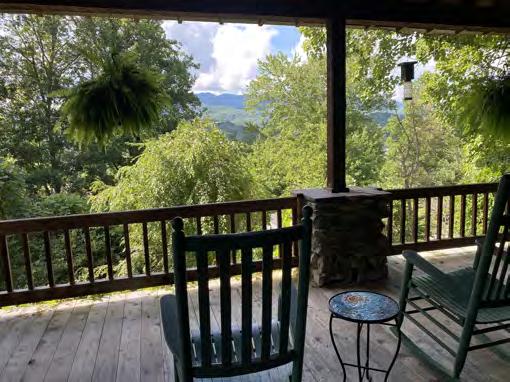

The Brown’s son, George Jr., is the chef, assisted by his son, Tyler. It’s the best food in town. (Full breakfast and dinner are included in the price of a room!) George’s wife, Monica, manages the inn. Their daughter works there when not at college. “Just about everybody in Swain County has worked here or taken swimming lessons in the pool. There are a lot of stories here. It’s a true family thing,” Monica said. The Browns are careful about who they hire because they don’t desire people who don’t love the inn, love the guests, or fit in
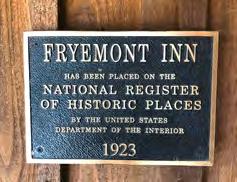
with the inn’s unique culture. “We’ve been so determined not to sell to a corporation.” She explained that so many historic inns have sold out, only to find that most of their guests get priced out. That happened to the Barganier’s when our favorite High Hampton Inn in Cashiers was purchased. The cost of staying there has since about quadrupled in price. “We have people who come every year. We know their situation. We know their lives. Some of these people have been staying with us for forty years. Some come twice a year,” Monica added. She said that one guest, in particular, has celebrated every birthday at the Fryemont. He’s now thirty-five. One of his parents is a hairdresser, the other a missionary. “I know what it takes for them to get here and how important it is to them.” Monica teared up. Another couple “… recently came with their grandsons who are twelve, sixteen and eighteen—they also brought their daughters here—and he has stage four cancer, is in a wheelchair, and has oxygen. He was, like, a mechanic. But it means so much for them to get here. People say this is like coming home,” she said.
The Barganier’s will be back. I want to sit on the wide porch, feel the mountain breeze on my face, and listen to the horn blowing down in Bryson City as the train leaves the station. It’s a grand spot to anticipate a shout and blast of another horn, and followers of Jesus will depart this Earth depot in the twinkling of an eye. Don’t you be left behind.
Visit the Fryemont soon. They close after Thanksgiving and won’t open again until April. Tell them Jeff and Cindy sent you. For more information, visit: www. Fryemontinn.com

Barganier is a novelist, travel writer and speaker. He travels far and wide upon the slightest excuse for something interesting to write about. His novels include Lawson’s Bluff (2021); The Slash Brokers (1998). He also manages Cindy Barganier Interiors LLC (www.cindybarganier.com) at The Waters in Pike Road, Alabama. Contact Jeff at Jeffbarganier@knology.net. You may print out his features at www.jeffbarganier.com and take them with you when you travel!
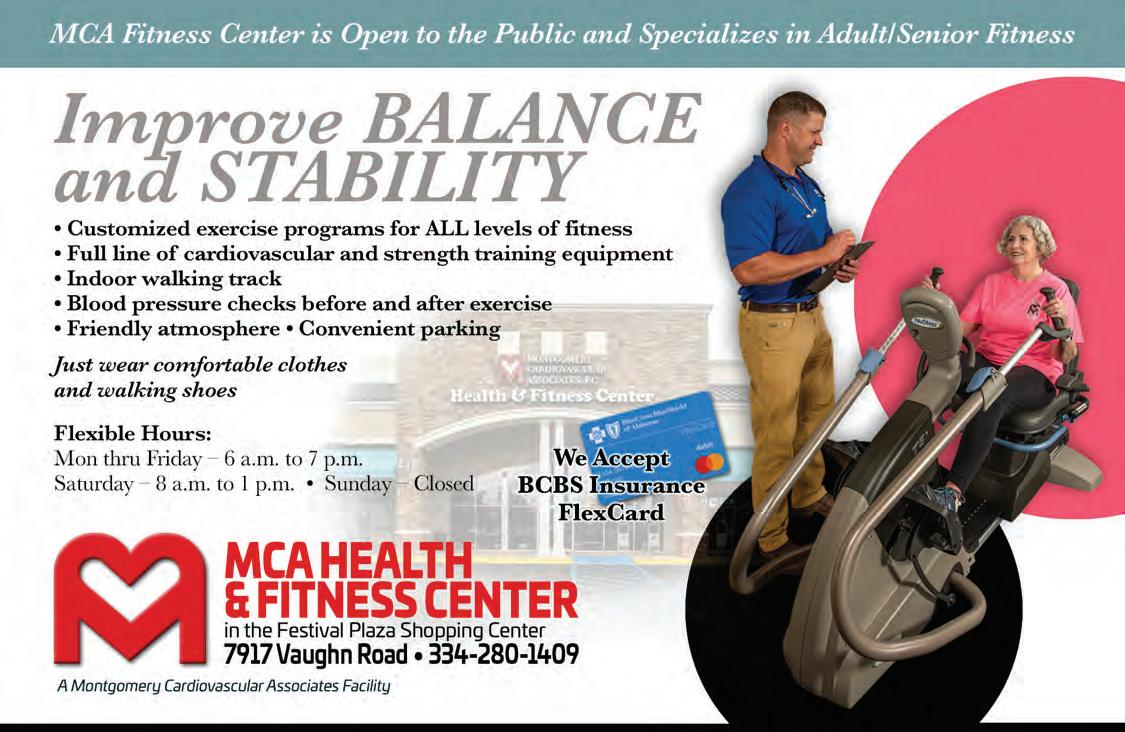
BAPTIST MEDICAL CENTER SOUTH
6,000+
7 OF TRAUMA %
OF STROKE PATIENTS i IN THE REGION HAPPEN @ BIRTHS WE CARE FOR CASES IN CENTRAL ALABAMA ARE TREATED @
BAPTIST MEDICAL CENTERS EAST AND SOUTH
MORE THAN % % OF AREA
TEAM MEMBERS ACROSS CENTRAL ALABAMA, AND GROWING
LARGEST COMPREHENSIVE Cancer Center 2020-2025
NAMED ONE OF FORBES’ BEST-IN-STATE EMPLOYERS FOR ALABAMA
When it matters most, more people choose Central Alabama’s leading healthcare provider.
From life-saving trauma care to life-giving maternity services, Baptist Health is trusted by more families, more patients, and more providers across Central Alabama. We lead in the moments that matter— because our people serve with skill, compassion, and purpose. In every hospital, every hallway, every delivery room, and trauma bay, our team shows up with unwavering commitment.
We don’t just care for the community—we are the community, and that’s why we’re here for life. BaptistFirst.org



On November 28, 1925, a fiddle cracked through the airwaves of WSM Radio in Nashville, Tennessee — and the South leaned in.
A 77-year-old championship fiddler named Uncle Jimmy Thompson played “Tennessee Wagoner,” and nobody listening that night could have known they were witnessing history. That broadcast — raw, joyful, unpolished — became the first spark of what would soon be called the Grand Ole Opry.
One hundred years later, that spark has never gone out.
The Opry has outlived wars, recessions, moon landings, the invention of television, the fall of record stores, the rise of streaming, and the TikTok generation. It has survived not because it chased culture — but because it anchored culture.
For generations, the Opry wasn’t just entertainment. It was Saturday night at home. It was radio glow on wallpapered living-room walls, shell-

backed chairs scraping wood floors, black coffee poured while babies were rocked to sleep. It was the South — not looking at itself, but simply being itself. And today — a century later — it still is.
Before the Opry, country music was scattered — porch pickers in East Tennessee, Appalachian hymns whispered through hollers, Texas dancehall cowboy songs with sawdust on the floor. There was no central place — no national stage — for the sounds of the working South.
That changed forever with 650 AM WSM. Owned by National Life & Accident Insurance Company, whose slogan was “We Shield Millions,” WSM launched a “barn dance” program simply to fill an evening time slot. Nobody expected a phenomenon. But as soon as it aired — the phone lines lit up. People heard voices that sounded like them. This

wasn’t opera. This wasn’t New York or Chicago. This was home.
On December 10, 1927 — WSM followed a classical music program called the Grand Opera. When it ended, announcer George D. Hay leaned toward the mic and said:
“For the past hour, we have been listening to music taken largely from the Grand Opera. From now on, we will present the Grand Ole Opry.”
It was a playful line — and a defining moment. The Opry wasn’t trying to be like the world. It was claiming its own.
From 1943 to 1974, the Opry took place inside the Ryman Auditorium — a former gospel tabernacle built for revival meetings — and the soul of that never left. The Ryman is where the Opry became holy ground.

• Where Hank Williams stunned the audience into silence.
• Where Minnie Pearl stepped onstage with “Howdy, I’m just so proud to be here!”
• Where Elvis Presley sang only once — and the Opry wasn’t ready for him.
• Where Patsy Cline, Roy Acuff, Johnny Cash, Bill Monroe, Loretta Lynn, and Dolly Parton turned songs into scripture.

• Garth Brooks crumbling into tears — overwhelmed that the Opry chose him.
But when the flood receded — the circle survived. It had risen. Just barely. Untouched. And every artist who steps there can still feel it.
The Opry has never once tried to act young. Because it never needed to. It simply stayed true — and waited for the world to remember what matters.
The seating was still pews. The reverence was still church. And when the Opry eventually moved in 1974 to its new permanent home, they cut a six-foot circle out of that Ryman stage and placed it dead center. The building may change. But the soul will not move.
It’s just wood. Until you see someone step into it. Then you understand. Every artist — no matter how famous — pauses. Some touch it. Some kiss their fingers and brush it. Some just close their eyes for one private breath.
Dolly has said the first time she stepped into the circle, “I was so nervous I couldn’t feel my legs.” Garth Brooks has openly wept at the memory.
For a hundred years — generations have passed through that same piece of floor. Hank. Patsy. Cash. Willie. Loretta. Reba. Alan. Vince. Carrie. Ashley. Jelly Roll. You don’t just perform on that stage. You join a living story.
Grand Ole Opry membership cannot be bought. It cannot be negotiated. It is a calling. And the invitation — “Will you join the Grand Ole Opry?” — is believed to be the single most emotional moment in all of country music. You can go back and watch:
• Vince Gill inviting Carrie Underwood — her knees buckling, tears flooding, voice gone.
• Charley Pride, Whisperin’ Bill Anderson, Roy Acuff, Ricky Skaggs — voices trembling but saying the same words: “It’s the greatest honor of my life.”
You don’t just play the Opry. You belong to it.
The Opry has survived everything. The Great Depression. People still tuned in. It was hope on the air.
World War II. Soldiers overseas listened through crackling static like it was mail from home.
The birth of bluegrass. Right there on its stage.
The 1960s. The country split apart — the Opry was one place everyone still said “yes.”
The 1990s & the Garth boom. Country became stadiums — but the Opry stayed church.
The digital age. It didn’t chase algorithms. It stayed rooted. And young artists came to it.
And then — perhaps most sacred of all — the flood of 2010. When the Cumberland River rose beyond all expectations, water poured into the Opry House — submerging rows of seats, backstage rooms, instruments, even dressing rooms that belonged to legends.
Today, more young artists than ever are begging to play the Opry — because you cannot fake legacy, and no marketing plan can manufacture soul. The Opry has soul. More today than perhaps ever.
Walk in today — any Saturday night — and you’ll see:
• A 20-year-old guitarist trembling backstage.
• A 78-year-old Opry matriarch patting their shoulder, whispering, “You’re home, baby.”
• A crowd filled with grandparents, children, veterans, nurses, farmers, dreamers.
• People standing when a hymn is sung, without being asked.
• People laughing when a corny joke lands — because they came to feel joy, not irony.
The world may be fast, cynical, curated —but inside the Opry? It’s still safe. It’s still real. It’s still ours.
What will the Opry be in 2125? A century from now, children not yet born will be stepping into that circle. And whether they're wearing blue jeans or futuristic light-glass boots — when their bootheel hits that piece of Ryman wood — they’ll feel exactly what Hank Williams felt.
Exactly what Dolly felt. Exactly what Jelly Roll felt when he broke into tears in 2024, saying he “couldn’t believe a place like this could still choose someone like him.”
They will stand there, heart pounding, one breath before singing… “Lord — don’t let me mess this up.”






BOOMers, it’s a challenge we face every November/December during the Season of Justifiable Over-Indulgence.
We know (with rare exception, and I’m jealous of THOSE people) we’re likely to add a pound or 10 to our weight.
Putting it on is effortless. We continuously seek an effortless way of ridding ourselves of the Holiday Chub and that can be tough and even dangerous.

At the end of this muse I will offer a foolproof weight loss program. First, let’s examine some of the popular shortcuts, like so-called “fad diets”. Ever try one of these?
The Cabbage Soup Diet. Step into 1980s nostalgia with seven days of cabbage soup—boiled with onions and tomatoes in an aroma reminiscent of sauerkraut and soggy pets. Every meal is soup: breakfast greets you with it, lunch adds a dish of existential dread, and dinner arrives as a greenish, accusing slime. Supporters claim you’ll shed ten pounds, but most of it's water weight and the rest is your will to persist. Bonus: loved ones might intervene when your breath rivals subway fumigation standards. By day five, plain toast seems gourmet. Spoiler alert—the lost pounds return swiftly, accompanied by a metabolism ready to stash away every calorie. And nobody wants to visit your home because .. the smell. You’ll look great-briefly- but be very lonely.
The Grapefruit Diet. What’s healthier than burning your throat with citric acid before each meal? This plan from the 1930s pairs half a grapefruit and protein, bans carbs—and enjoyment. Supposedly the enzymes "melt fat,"
though what actually melts is your stomach lining. People report dreaming of bagels while their tongues turn numb. One participant claimed a twelve-pound loss, eight thanks to her dissolving enamel. Tip: keep antacids handy for peak regret.
Paleo—Bench-Pressing Mastodons. Eat meats, nuts, and berries, but skip grains, dairy, and fun. Never mind that real Paleolithic humans ate whatever they could find and rarely saw forty. Modern Paleo fans grill steaks and wear kale loincloths, balancing the cost of groceries and proteininduced constipation. Ironically, archeologists found evidence ancient people ate bread—so much for primal living.
Keto, Butter Bonanza. Force your body to burn fat by avoiding carbs.
“in ketosis.” Early results include fast water loss and energy sparks, but soon come brain fog, “keto breath,” possible gallstones, and friendships limited to cauliflower rice support groups. Success stories often end with regaining more than lost after a stray pretzel.
Intermittent Fasting, Scheduled Starvation. Eat only between noon and 8 p.m. Mornings are fueled by black coffee and frustration. Advocates praise cellular cleaning (autophagy), critics note hangry partners and increased therapy expenses. Your dog learns to hide snacks.
The Cotton Ball Diet. It’s real—soak cotton balls in juice and swallow them for zero calories and maximum hospital visits. A true contender for a Darwin Award Dieters.
Exhibit H: The Baby Food Diet. Adults spoon pureed veggies at work to chase health, as touted by celebrities, while dignity disappears.

Breakfast becomes butter-infused coffee, lunch is bacon wrapped in cheese, and dinner features steak in hollandaise. Test strips turn purple, showing you're
Have you ever downed some Gerber’s as an adult? You’ll better understand why some tykes close their hangers to the “airplane”. Yuk. All these diets have common threads: strict restriction, shortlived benefits, and inevitable rebound. They prey on hope, not science. Science told me a swill of apple-cider vinegar would help curb appetite and burn fat. The rest of that bottle is around my house somewhere along with the Poison Control Hotline number.
Viagra was originally developed as a treatment for high blood pressure. Soon, men noticed a welcome side effect. Many men burn fun calories using this medication.
In a similar vein, Ozempic was originally created as a treatment for type 2 diabetes. It is also used to help lower the risk of certain heart or blood vessel problems in adults who have both heart disease and type 2 diabetes. Like Viagra, Oh-Oh-Oh Ozempic had an interesting and popular side effect- weight loss. Substantial weight loss.
Ozempic has been great for helping people live their best life with diabetesand insurance covers it for that purpose. However- and I looked into it- $400 to $1300 per month if prescribed for weight loss. Too rich for me.
As Ozempic’s popularity soared, so did news of unpleasant side effects. Unlike Viagra’s original side effect (more sex), the big O has produced “Ozempic Face” (pictured). It takes fat from everywhere, including cheeks and chins which gives the face a hollowed-out, predecomposition look.
More recently, reports of “Ozempic Feet” (pictured) have surfaced as odd flaps of skin show up on the feet.
The foolproof weight loss program I referenced earlier? “True weight loss occurs naturally when the number of calories burned exceeds the number of calories consumed”. Boring, tough but it works.
To each his own I say. Whatever works for you. But there’s one last side effect to Ozempic you should know about.
Unless it’s prescribed as a necessity you may find yourself suffering from Ozempic Bank Account!
Oh Oh $0 point 0!
Happy Thanksgiving my BOOMer brothers and sisters.


Greg Budell has lived in Montgomery for 20 years. A 50+ year veteran of radio, TV and writing, Greg hosts the Newstalk 93.1FM Morning Show with Rich Thomas, Susan Woody, and Jay Scott, 6-9 AM Monday - Friday. He returns weekday afternoons from 3-6 PM for Happy Hour with Pamela Dubuque and a variety of sidekicks. His favorite topic is life! Greg can be reached at gregbudell@aol.com.





Many of us have a childhood memory of a grandparent lamenting, "Time seems to go by faster every year." This made no sense to a kid for whom days could seem to last forever.
As you've gotten older you perhaps catch yourself saying the same thing. But hold on a minute (pardon the pun). No matter our age, the second hand on a clock always tick-tick-ticks with unwavering regularity.
How are different perceptions of time even possible?
Here is a relatable example. You plan a fun vacation to a new destination that will last for a week. Excitement builds as the date of departure approaches. Once there, the days seem to go by in a flash and before you know it, you're home again.
When you return home, "the reason you feel as though you've been away for ages is that so many new things have happened that you have far more new memories than in a normal week."
But when looking back on your trip, it oddly seems like you were gone for quite some time. Was it only a week? Conversely, think of when you were in bed with the flu or a bad cold. The hours dragged by endlessly. Yet, after you are well and have resumed your regular routine, you know you were sick, but all that time spent in bed hardly registers in your memory.
The common denominator in both of these illustrations of differing perceptions of time is new experiences. In the first, dubbed the "Holiday Paradox" by British author and lecturer Claudia Hammond in her awardwinning book "Time Warped," your daily life is suddenly disrupted by a flood of newness that throws off your typical cues for the passage of time.
When you return home, "the reason you feel as though you've been away for ages," she says, "is that so many new things have happened that you have far more new memories than in a normal week."
In the second situation, Hammond says, "There is no fun. There is no novelty.

Only plenty of repetition, mainly of the experience of feeling awful." Looking back on the days spent in bed, you of course remember being ill, but the lack of variation in your memories causes that period of time to seem as if it barely happened.
Scientists have verified that exposure to variety creates memories, which in turn makes time seem to pass slower because there is more to look back on.
For children, fresh experiences and "firsts" are a natural part of everyday life — losing that first tooth, first day of school, first bicycle. This constant stream of new occurrences stretches the passage of time in a young mind.
Older adults, on the other hand, often slip into predictable patterns where days differ only by the calendar date. With scant new memories being formed between existing time markers like birthdays and holidays, Christmas seems to roll around quicker each year.

So as simple as it sounds, if you want time to slow down, the key is to intentionally introduce more novel experiences into your daily routine. Researchers divide these into two categories:
Common novelty. You decide to try a different restaurant in your neighborhood instead of the ones you normally frequent. It’s new but related to something you already know, so the impression is not particularly powerful.
Distinct novelty. Taking a trip to somewhere you have never been fires a whole different system in your mind that preserves all the details like a highresolution photo, creating vivid memories you recall for years to come. Your brain’s reaction is, “This looks important. I’d better save all of this!”
Here are six simple ways to experience your life as a full-length movie instead of a trailer:
Vary your routine. We develop routines to keep our lives running smoothly without a lot of mental effort. But are you in a groove or a rut? Break up your habitual activity in small ways like sometimes taking a different route home or experimenting with an interesting recipe.
Turn off your mental autopilot. Keep your brain engaged and the memories coming by learning new skills, going to new places and trying new activities. Again, massive disruption or daily adventures aren’t required. Simply stay present and aware whenever possible.
Reduce time on social media. Under the promise of variety and engagement, social media algorithms instead present a procession of look-alike posts that waste time and dull the brain. Break the habit of endless, passive scrolling.
Spend time in nature. Go for a walk in the woods. Studies show that people tend to feel time moving slower when they are in a natural setting. Being out of our typical fastpaced, stressful environment seems to help

us focus on the present moment instead of calendars, schedules and obligations.
Stay curious. Although it may have been sidelined long ago, we never lose our childlike curiosity. Be open to different ideas and ways of seeing the world. Lifelong inquisitiveness is a gateway to expanding your horizons.
Even though you now know what causes the sensation of time flying by, you may very well decide that implementing the ideas suggested is too much trouble. As Hammond notes, "Maybe part of growing older is having the option to spend more hours doing what you know you like best, rather than seeking out new experiences."
However, extensive research has found that the happiest people treat their time as a precious asset and manage it wisely. To create the perception of time passing more slowly, use these tools to lengthen your days while adding treasured pages to your "memory book."
Courtesy of nextavenue.org.

Pinterest is a liar.
According to the internet, Thanksgiving should look like a Norman Rockwell painting sprinkled with glitter. Perfect turkeys, designer centerpieces, smiling families basking in soft autumn light, all while golden retrievers nap peacefully by the fire.
My Thanksgiving? The smoke alarm’s going off, the gravy’s bubbling over like Mount Vesuvius, and the turkey is so dry it could double as kitty litter. I saw tumbleweed roll through the breast meat. Even the dog sniffed it and walked away like, “I have standards, Carl.”
Let’s talk about the table. Pinterest gives you hand-lettered place cards and heirloom china passed down through generations. Mine has a folding table from the garage with a wobbly leg, four mismatched chairs, and a child’s plastic booster seat zip-tied to a barstool. The tablecloth has cranberry stains from 2019 that I now consider “vintage.” The grandkids eat picnic-style on the floor because no one has yet invented a dining room that seats 18 unless you’re part of a royal family—or own a Golden Corral.
And then there’s the family.
Pinterest doesn’t show Uncle Larry explaining his latest conspiracy theory while I’m just trying to keep the dinner rolls from catching fire. Or my brotherin-law asking if the turkey is “organic,” as if I raised it in the backyard on an acorn diet and read it bedtime stories.

And my mother-in-law? She floats behind me like a Thanksgiving specter whispering, “Bless your heart, you tried.” Yes, Janet. I tried.
Let’s not forget the side dishes. Pinterest’s stuffing has pomegranate seeds and sage bundles. Mine? Box mix, because I’m feeding a horde and not trying to impress Gwyneth Paltrow. The mashed potatoes turned to glue, the green beans are mush, and someone always insists on bringing that cursed Jell-O salad with mystery fruit inside—like a science experiment we all politely ignore.
Then there’s “Friendsgiving.”
Look, I’m glad the younger generation celebrates gratitude with their buddies, but let’s not pretend it compares.
Friendsgiving is wine, charcuterie boards, and people saying things like “these brie bites are to die for.”
Nobody’s chasing toddlers, managing in-laws, or scrubbing a roasting pan at midnight with gravy up to their elbows. You want to see what Thanksgiving really looks like? Come to my house. We’ve got toddlers licking the pie, Grandpa yelling
at the TV, and three simultaneous conversations about cholesterol meds.
And yet—between the spills, the squabbles, and the smoke—there’s magic. There’s the chaos of kids playing football in the yard, even if they tackle a shrub and cry. There’s the same family stories told for the 47th time, and somehow, they’re still funny. There’s pie for breakfast, naps after lunch, and that one moment when everyone is full, sleepy, and happy... and I think, Yeah. This is it. This is what it’s all about.
So yes, I’m grumpy. My Pinterestperfect dream looks more like a Pinterest fail. I’m sore, stained, and out of Tupperware. But I’m grateful— grateful for family, for the noise, for the laughter, and even for the lumpy gravy. Because Thanksgiving isn’t about picture perfection.
It’s about the glorious, gravysoaked, love-drenched circus that shows up to eat it.
- Archie Grumbleton








You misplace your keys, can't recall why you walked into a room, or forget the name of someone you just met. Blame it on your shrinking brain. The brain is packed with highly specialized cells called neurons that help you think, learn and remember, as well as billions of other support cells.
Brain cell loss is a natural part of aging but can result in cognitive decline and memory issues. While many factors influence brain health, a nutritious diet that includes these six nutrients can help slow the effects of time.
"The brain's defense mechanism relies on a just-right dose of magnesium," according to Annie Fenn, M.D., author of "The Brain Health Kitchen: Preventing Alzheimer's Through Food." She says, "Magnesium deficiency has been associated with neurodegenerative disease, such as Alzheimer's and Parkinson's."
A 2023 study of men and women 40 to 73 years old found that more magnesium was linked to a greater brain volume. Though it's unclear exactly how magnesium contributed to preserving cognition in this study, the mineral is known for deflecting cell damage and inflammation.
Experts suggest women consume 320 milligrams (mg) of magnesium daily and that men should get 420 mg. Unfortunately, older adults tend to have lower magnesium intake. To make matters worse, the body absorbs less magnesium and loses more with age.
In addition, certain medications that treat reflux disease and elevated blood pressure can deplete magnesium levels in the body. Ask your doctor if your medications affect your magnesium status.
At 156 mg of magnesium per ounce, pumpkin seeds are among the best

magnesium foods. Almonds, spinach, peanut butter, black beans and yogurt are good or excellent sources. Though it's preferable to get magnesium in your diet, the amount of a regular multivitamin can help bridge small gaps in food intake.
The body uses the amino acids in food proteins to produce brain cells, neurotransmitters and other compounds that support brain health. For example, one study that followed more than 77,000 men and women for over 20 years found that more protein was associated with less cognitive decline later in life.
Legumes, fish and lean poultry proved superior in protecting brain function, while processed meat products, including hotdogs, were related to poorer cognition. In another 2023 study involving more than 6,900 people without cognitive impairment or dementia at the start, a greater protein intake protected the brain over time.
"All animal foods have complete protein and certain plant foods, including soy, quinoa and buckwheat do, too," Boules adds. Pistachios also offer complete protein.
Protein needs are based on body weight. Generally speaking, three ounces of cooked fish, poultry or lean meat supplies about 20 grams of protein, six ounces of Greek yogurt contains 17 grams, and one whole egg has six grams.
Meeting protein needs can be challenging when you have a small appetite. Further, protein requirements may increase with age. Be sure to include lean and low-fat protein foods at every meal.
Choline helps shore up brain cell membranes, most notably neurons. In that regard, choline wards off cell damage. Choline also serves as the raw material for acetylcholine, one of dozens of neurotransmitters, which are compounds that allow neurons to communicate with each other.
One observational study found that in people over 60, consuming between 187 and 400 mg of choline daily from foods and supplements reduced the risk of low cognitive function by about 50% compared to getting less than 188 mg daily. The National Institute of Medicine suggests 550 mg of choline daily for men and 425 mg daily for women.
Choline is concentrated in high-protein foods: one large whole egg contains 147 mg of choline, three ounces of cooked chicken breast has 72 mg, and 1/4 cup of roasted soybeans supply 53 mg. Other plant foods have lesser amounts of choline.
While most people think of fiber as something to keep the gut moving, Fenn says it also plays a crucial role in keeping your brain healthy.
Research conducted with more than 3,700 men and women 40 to 64 years old who were followed for 20 years found that higher levels of fiber, particularly the soluble kind, were associated with less dementia. The low-risk group in the study consumed 20 grams of fiber on average every day, and those with the most significant risk averaged just eight grams of fiber a day.
Fiber is found naturally only in plant foods. Both types of dietary fiber support brain health in different ways. The soluble fiber in foods such as oats, nuts and legumes promotes normal levels of cholesterol and glucose in the blood, which helps protect the integrity of blood vessels and promotes better blood flow to the brain.
Insoluble fiber, predominant in whole grain bread, cereals and brown rice, keeps you fuller for longer and can aid weight control. Many foods contain both types of fiber — the recommended intake is 28 grams daily on a 2,000-calorie diet. So include at least five servings of fruits and vegetables and three servings of whole grain foods daily to help satisfy fiber needs.
Fish for the Win
According to the American Heart Association, omega-3 fats defend against cell destruction and protect arteries that nourish the brain by discouraging blockages and lowering blood pressure.
Not all omega-3 fats are created equal. Docosahexaenoic acid (D.H.A.) and

eicosapentaenoic acid (E.P.A.) are the primary preformed omega-3 fats associated with brain health. Certain plant foods, such as walnuts, flax and chia seeds, contain alpha-linolenic acid, an omega-3 fat that the body can turn into D.H.A. and E.P.A., although the conversion rate is low.
Aging limits the body's ability to absorb natural vitamin B12 because older people produce less stomach acid required to process it.
Brain cells are particularly rich in D.H.A. Researchers have observed that higher levels of D.H.A. in the blood delayed the onset of Alzheimer's disease by nearly five years in people aged 65 and older without dementia.
To meet omega-3 needs, the Dietary Guidelines for Americans (D.G.A.) recommends eating eight ounces of fish, which is rich in D.H.A. and E.P.A., weekly. If you avoid fish or eat small amounts, you may benefit from a supplement with about 1,000 milligrams of E.P.A. and D.H.A. combined.
Omega-3 supplements can interact with the medication you take, however. "Always check with your medical provider before starting a supplement," Boules suggests.
Value Vitamin B12
Vitamin B12 helps maintain myelin, which coats some parts of neurons and ensures swift and accurate communication. However, researchers believe that myelin shrinks with age, slowing down processing and reducing cognitive function between all aspects of the brain.
Vitamin B12 is found naturally only in animal foods. After age 50, rely on synthetic B12, found in dietary supplements and fortified foods, to meet vitamin B12 needs — 2.4 micrograms daily. For example, one serving of fortified cereal can provide 25% of the suggested daily intake. Synthetic B12 is processed without stomach acid, making it available to the body.

Courtesy of nextavenue.org.








The Jay and Susie Gogue Performing Arts Center at Auburn University launches its 2025–26 Broadway Series with the North American tour of the joyful and triumphant smash hit “TINA—The Tina Turner Musical.” The three-night engagement will run December 2–4 at the Woltosz Theatre.
“TINA—The Tina Turner Musical” was written by Tony Award nominee and Pulitzer Prize winner Katori Hall with Frank Ketelaar and Kees Prins. The new tour is produced by Crossroads Live North America.
Darilyn Burtley is joined on tour by Monty Kane (Ike Turner/Ronnie Turner), K. Bernice (Zelma Bullock), India Shelbi Boone (Tina Turner at certain performances), Eva Ruwé (Gran Georgeanna) and Eleni Kutay, (Rhonda Graam/Toni Basil).

“TINA—The Tina Turner Musical” is the inspiring true story of a woman who defied racism, sexism, and ageism to become the global Queen of Rock 'n' Roll. This smash-hit stage production celebrates Tina Turner’s resilience, talent, and triumphant rise from a small-town girl with a big voice to an international icon. Featuring some of her biggest hits, “What’s Love Got to Do with It,” “Proud Mary,” “Nutbush City Limits,” “The Best,” and “River Deep –Mountain High,” the show has captivated over 8 million theatergoers worldwide with its powerful message and electrifying energy. One of the best-selling artists of all time, Tina Turner won 12 Grammy Awards and influenced generations with her music, performances, and unshakable spirit. She was inducted into the Rock & Roll Hall of Fame in 1991 with Ike Turner and later nominated in 2021 for her solo career. Her legacy lives on and continues to inspire strength, hope and transformation. Tickets are available for all three performances and can be purchased online at goguecentertickets.auburn.edu, by telephone at 334.844. TIXS (8497), and in person at the Gogue Center box office, located at 910 South College Street, Auburn, Alabama.

MANIA: The ABBA Tribute at MPAC November 8 I 7:30 PM to 10:00 PM
A world-renowned celebration of the legendary Swedish supergroup, having performed over 3,000 shows across 35 countries and on every continent. Following a successful West End run in London’s Shaftesbury Theatre and a sold-out 80-date U.S. tour, Mania continues to dazzle audiences with stunning costumes, energetic choreography, and faithful renditions of ABBA’s greatest hits—from “Dancing Queen” and “Mamma Mia” to “Waterloo” and “Take a Chance on Me.” With electrifying performances and timeless music, Mania delivers an unforgettable experience that captures the magic, joy, and spirit of ABBA for fans old and new. $23.50 - $70.50 Additional fees may apply. https://mpaconline.org/mania-the-abba-tribute/
Please present coupon or mention you saw it in the BOOM! Digital Issue. Offer Expires 11/30/25







November 17 I 7 PM to 9 PM I Troy University's Davis
Join the Montgomery Symphony Orchestra for an evening celebrating the music of renowned American composer Tobias Picker. The program features his expressive and dynamic Cello Concerto, performed by internationally acclaimed cellist Santiago Cañón-Valencia. Don’t miss this captivating concert highlighting Picker’s bold, lyrical voice and a stunning solo performance. Ticket: $10 - $42. https://ci.ovationtix.com/36871/production/1209712
November 19 I 10 AM to 2 PM I 113 Madison Avenue
Join the Episcopal Church Women (ECW) for an event that will feature a silent auction, handmade crafts, a pantry of homemade casseroles, soups, and breads, and a treasure attic filled with gently used household goods, china, silver, and seasonal décor. Guests can also enjoy a delicious luncheon featuring honey French chicken, potatoes au gratin, fall salad, rolls, dessert, and drinks for $15 per ticket, available for dine-in or drive-through. All proceeds support the local outreach projects. Call 334-262-1937 or email constance@stjohnsmontgomery.org.


Hilltop Public House is bringing back the beloved Miracle at Hilltop, an over-the-top Christmas-themed pop-up bar transforming the Cottage Hill neighborhood (Montgomery) into a festive wonderland. The holiday experience promises even more dazzling décor, creative cocktails, and merry vibes than before. Part of the globally acclaimed Miracle pop-up series, it features returning favorites like the Christmapolitan and Snowball Old-Fashioned, along with new seasonal drinks served in collectible glassware. https://www.facebook.com/miracleathilltop
We are proud to recognize Shona Johnson as our Caregiver of the Month! Shona has continually gone above and beyond in her role, providing not only phenomenal care but also creating genuine connections with those she serves. Her clients share wonderful feedback about her kindness, compassion, and the way she makes them feel truly supported. Shona’s professionalism, reliability, and dedication set her apart. Whether it’s offering comfort in challenging moments, going the extra mile to meet a need, or simply brightening someone’s day with her warm presence, Shona makes a meaningful difference in every life she touches.
Thank you, Shona, for the heart you put into your work and the shining example you set for all of us. We’re grateful for your commitment and proud to have you on our team! For more information visit www.homecareassistancemontgomery.com.









When Carla and Bill Simmons downsized from a large suburban home to a cozy two-bedroom condo, their friends expected them to feel deprived. Instead, they felt lighter — financially and emotionally. Without the big mortgage, endless rooms to clean, and constant home repairs, the couple had more money for dinners with friends, weekend getaways, and the ballroom dancing classes they had always wanted to take.
“We realized we weren't giving anything up,” she says. “We were finally making space — and money — for the things we truly love.”
Our culture tells us that more is better — a bigger house, a newer car, a full closet. But research shows that once basic needs are met, more “stuff” doesn’t necessarily make us happier. What does? Experiences, relationships, and a sense of purpose.
When you stop measuring life by possessions and start measuring it by moments, you open the door to a different kind of wealth.
Autumn naturally brings a back-to-basics energy. We swap out summer wardrobes, tidy up the garden, and prepare for the
For many of us over 55, “living well” doesn’t have to mean “spending more.” In fact, some of the happiest people are those who’ve learned to thrive on less — especially in seasons of rising costs and shifting priorities.
Holidays. It’s a great time to take stock of where your money is going — and whether it’s really serving you.
• Are you paying for subscriptions you don’t use?
• Is your grocery bill higher than it needs to be?
• Do you own more clothes than you wear?
A few intentional changes now can free up cash for what matters most.
Audit Your Expenses – Print out last month’s bank statement and highlight every purchase that didn’t bring real value.
Embrace the “One In, One Out” Rule – For every new item you buy, donate or sell one you already have.

Cook More at Home – Try a “restaurant night” at home with candles, music, and a special recipe.
Travel Smart –Look for off-season deals, house-sitting opportunities, or short getaways nearby.
Borrow or Share – Tools, equipment, and even holiday décor can be swapped with friends or neighbors.
Less spending often leads to less
Cancel one unused subscription.
-------
Plan a week of meals before shopping.
-------
Invite friends for coffee at home instead of meeting at a café.
Sell one item you haven’t used in a year.
Walk or bike instead of driving for short trips.
Check your credit card for recurring charges.
-------
Borrow a book or movie from the library.
-------
Do a no-spend weekend challenge.
-------
Use store rewards points before they expire.
-------
Shop your closet before buying new clothes.
clutter — and that can improve mental health. A 2016 UCLA study found that people with cluttered homes had higher cortisol levels, the stress hormone. When your space is calmer, your mind is calmer too.
Living on less doesn’t mean living without. It means choosing luxuries intentionally — a really good cup of coffee, a fresh bouquet of flowers, a ticket to a concert you’ll remember for years.
By saving in areas that matter less to you, you can spend more freely on what you truly enjoy.
When you think back on your favorite memories, they’re rarely about the things you bought. They’re about the time you spent, the people you were with, and the way you felt.
This season, consider what you could let go of — a bill, a possession, or a commitment — to make room for more of what makes you feel alive. Living well on less isn’t about sacrifice. It’s about freedom.



By
On game days in Tuscaloosa, traffic grinds to a chaotic crawl as some 100,000 fans converge on the westcentral Alabama town’s football stadium. However, during the other 350 or so days of the year, residents and visitors seek out other diversions, including the town’s libraries, museums, theaters, and performance venues such as the recently renamed 8000-seat MercedesBenz Amphitheater.
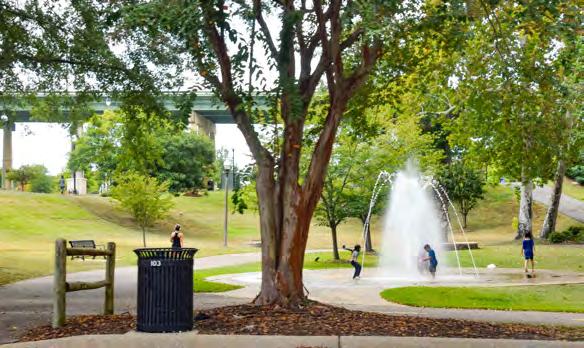
The parking lot adjacent to that 15-acre outdoor arena on Jack Warner Parkway serves as the launching point for walkers, joggers, and cyclists setting out to explore the city’s 4-mile Riverwalk along the scenic Black Warrior River. The path is easy and ever-soslightly downhill, offering a relaxed stroll amidst the lush suburban vegetation. Keep in mind, though, it’s not a loop – you’ll need to retrace your steps unless you arrange a pickup further along the path. For a shorter option, consider turning back at the halfway point at the Marr’s Spring Road traffic light.
A paved path marked with yellow dashed lines guides visitors the entire path, beginning at the amphitheater, where you’ll walk past the historic Tuscaloosa truss railroad and beneath busy Lurleen B. Wallace Blvd. At the park’s gateway, there’s plenty of seating, open grassy spaces, a whimsical sunflower-shaped bicycle rack,
and several bright blue police emergency call boxes. Just beyond a gentle dip, the path encircles a striking metal sculpture celebrating Tuscaloosa’s twin cities in Japan, Germany, and Ghana, while a nearby fountain offers children a refreshing cooling station during the warm months.
Flanked by the river to the left and Warner Parkway on the right, the path can be noisy at times but is largely a peaceful walk passing the River Market building after about a mile or so. Open every Saturday from 7 am to noon, dozens of booths display produce, baked goods, and crafts. Just past the market, staff at the town Visitor Center can answer Tuscaloosa-related questions. Outside the Center, a bronze statue honors local sports hero Deontay Wilder, former World Boxing Council heavyweight champion.

another quaint bike rack fashioned after a yellow dinosaur skeleton. Then there’s the distinctly odd mini-Stonehenge, just as mysterious as the original structure some 4,000 miles away in Wiltshire, England. The path continues over several small pedestrian bridges leading to a side path with Nick’s Kids Playground sponsored by, amongst others, a famous sporting Nick who needs no introduction in Alabama.
At the halfway point at the abovementioned traffic light, you can either turn back for a 4-mile round trip or continue another 2 miles, passing the

University of Alabama’s main entrance and a few other surprises along the way, which, if you go the distance, would make an 8-mile round trip.
Continuing your walk, you’ll next encounter Moonshot Creamery (they open at 1 pm Monday through Saturday) at The Shops at Riverwalk Place. Don’t feel guilty if you’re tempted by ice cream flavors such as Creme Brulee, Blueberry Cheesecake, or Caramel Brownie. You are, after all, only human.
Public restrooms can be found nearby, as well as
As daylight fades, soft lamp lighting illuminates the path, creating an inviting environment, should you fancy an evening walk along the river in Alabama’s fifth most populous city.
Nick Thomas teaches at Auburn University at Montgomery and has written features, columns, and interviews for many newspapers and magazines. His hiking column describes short trails, hikes, and walks from around the country that seniors might enjoy.
See www.ItsAWonderfulHike.com.

Baptist Health ENT Partners is growing to better serve the river region with the opening of a new, state-of-the-art location at Baptist Medical Center East. Leading the team at the new location are board-certified otolaryngologist, Dr. Stephen Chandler and experienced nurse practitioner, Rebecca Alexander—offering expert care for both adults and children. Together, they provide compassionate, personalized treatment for a wide range of ear, nose and throat conditions. With this additional location, patients now have even more convenient access to high-quality ENT care.
Acid Reflux
Deviated Nasal Septum
Ear Diseases & Tumors
Lips & Tongue Tie
Sinonasal Diseases & Tumors Sinus Infections Smell & Taste Disorders
Vocal Cord Polyps & Nodules Balloon Sinuplasty

Our
Stephen W. Chandler, MD
Rebecca Alexander, CRNP
Tonsillectomy / Adenoidectomy
Kim Mason is living proof that curiosity—and courage—don’t come with an expiration date. In this inspiring interview, the beloved actor, director, and longtime portfolio advisor opens up about feeling more confident than ever, the power of mentors who spoke life into her, and why she’s still intentionally chasing things that scare her—like learning the stand-up bass and writing original theatre. From touring nationally with ABC Television to quietly changing lives through financial advising, Kim’s story is a beautiful tapestry of creativity, grit, reinvention, and late-in-life love. If you’ve ever wondered whether your best days might still be ahead—Kim will make you believe they absolutely are.
BOOM: Kim, you recently celebrated your 61st birthday in October—Happy Birthday! What’s this season of life teaching you about who you are and who you’re still becoming?
Kim: I was just thinking to myself the other day that it feels good to know things. To feel comfortable in my own skin. To know how to hold a conversation or manage a situation that would have been difficult or even impossible for my younger self to do. There’s a comfort in knowing that you’ll be able to handle most things that are thrown at you. For me, that has come with age and experience.
As for who I’m becoming, each of us has a limited number of days on this planet. I’m becoming more and more aware that those days are waning. That gives me a sense of urgency, in a way. I still have so many things I want to try for the first time, and to get better at, and to accomplish and refine. In the buffet of life, I feel like I’ve only made it to the salad bar.
BOOM: You’ve been acting for more than 40 years. Take us back—what first sparked your love for the stage?
Kim: When I was a teenager, my high
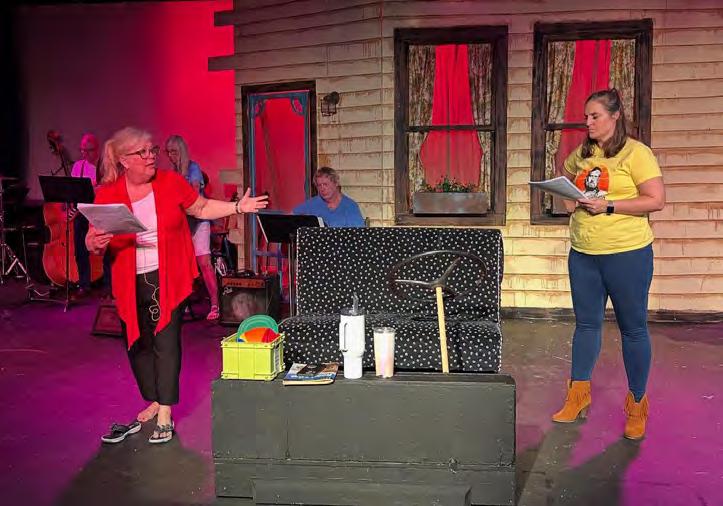
school choral teacher convinced me to be in my first musical. It was an old, rarely-performed show that the high school was doing called Irene. I was cast as one of Irene’s crazy sidekicks, and I had never had such fun in my life. Performing, singing, and dancing came easily to me, and I’d never had much instruction in any of it. That same teacher looked me square in the face, and with such seriousness, she said, “You’ve got it. You’ve got something special. You’ve got IT.” I wasn’t sure
what “it” was, but for some unknown reason, I was glad to have it. After that, I began taking voice lessons, acting classes, and dancing lessons to see if I could cultivate “it”. And, I’ve been hooked ever since.
BOOM: Touring nationally with ABC Television and performing professionally for a decade must have been quite an adventure. What moments from that time still stay with you?
Kim: The camaraderie that’s forged
from spending day in and day out with the same people for months at a time stays with me. I’m still friends with many of the people I performed with, even though we are scattered all over the globe and most of us have gone on to do professions other than in the arts.
BOOM: Today, you balance acting with directing at The Wetumpka Depot and The Red Door Theater. What do you enjoy most about being on the other side of the stage as the Director?
Kim: Directing is completely different than acting. When you’re doing a role in a show, you’re only responsible for yourself and the part you’re playing. When you direct, especially in community theatre, you are responsible for just about everything – costumes, sets, props, casting, scheduling, managing personalities. I actually enjoy directing more than acting these days. I love seeing the big picture and getting to shape how the story is told. And if I’m lucky enough to have others to collaborate to with, like a choreographer or lighting designer, then it’s really fun. But if I’m honest, the absolute best thing about directing is helping someone shine in a role they’re playing. At first, they may be timid or unsure, but through encouragement and exploration, they start to gain confidence. Seeing them grow and learn is a thrill to me. By the time opening night rolls around, my hope is that they are extremely proud of themselves and the show we’ve all created.
now as a Portfolio Advisor. What drew you to that career?


Kim: It’s been said that “necessity is the mother of invention”, and in this case, necessity was the mother of my career. I had to get a job. I had a baby and was newly on my own in a new town. I came to Jackson Thornton by way of a career placement agency. I started out as the receptionist. I was later asked if I would be willing to move to internal accounting. Once there, I was able to work more closely with the principals of the Firm. It was after about a year in that position that I was invited to join the Asset Management group by its founding member, Lanny Crane.
Even though I didn’t come from an accounting or financial background, I caught on quickly and soon took it upon myself to study for the Series 65 Advisor Exam. I took the exam without telling anyone for fear of failing. I was thrilled to come into work and be able to tell them I had passed. It all just grew from there. Twenty years later, I have learned so much from my associates and supervisors. And I now have many of my own clients that I enjoy advising and taking care of.
know what I’d do without you.” How do compassion and communication play a role in helping people through life’s transitions?
Kim: It may sound crazy, but I think theatre has influenced what I do as a financial advisor. It taught me to listen… to really listen. Many times, what people really need is to be heard. I truly care for them. Jackson Thornton has a culture of going the extra mile for our clients. I am happily a part of that culture. If there’s something I can do as an advisor to make our clients worry less, accomplish more, have a life better life, that’s what I want to do.
BOOM: You’ve mentioned two mentors who deeply shaped you—your highschool choral teacher and Lanny Crane at Jackson Thornton. What lessons from them still guide you today?
BOOM: Your “day job” is quite a contrast—you’ve spent 23 years with Jackson Thornton Wealth Management,
BOOM: I know you’ve heard clients say, “I don’t


Kim: I have never forgotten what it felt like for my high-school choral director, Donna Norton, to believe in me. She pushed me, she encouraged me, and she never let me take the easy way out. When I thanked her later in life for helping me succeed in theatre, she said, “It wasn’t me, cream always rises to the top.” I’ll always remember her dedication to her students and her humility.
As for Lanny Crane, he taught me not to be afraid of a challenge. He was tough on everyone, including me, and had extremely high standards that he expected everyone to live up to. He also held himself to these standards. But he was always fair, always listened, and was generous with his praise and encouragement. He often told me I was smart. If Lanny Crane told you you were smart, you believed him, and you felt fortunate.
the new things you’re exploring right now?
Kim: I’m learning to play the stand-up bass. It’s taller than I am and hard to handle sometimes, but it’s so much fun. My fiancé Matt is teaching me. I played violin for years, but this is a bit different. Matt is a wonderful musician, and we play together. I remember the first time I played in public – it was terrifying.
I’ve also started writing. I’ve written two plays and a jukebox musical. I was lucky enough to have a staged reading of my musical Dime Store Cowgirl at the Wetumpka Depot recently. It’s a little scary having your words said out loud to an audience. You’re always wondering how it will be received. I’m hoping my play “Call Girl” will have a reading soon. Who knows, maybe one day I may have one published.
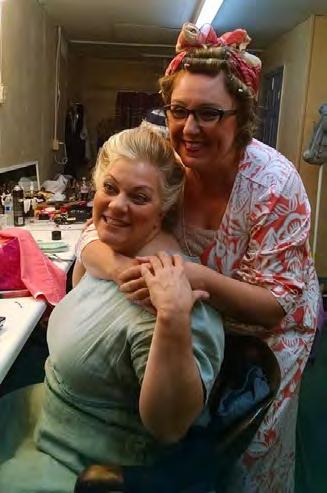
BOOM: You’ve recently become engaged—congratulations! What has it been like to find love again in this stage of life?
Kim: I wasn’t looking for love, certainly not a husband. My life was full …of work, friends, laughter, music. I was happy. Matt and I worked together at Jackson Thornton for years before being anything other than co-workers. A chance meeting in the lunchroom began a conversation that led to my inviting him to see a show that I was in. He came to the show, a musical, and afterwards told me that he played “a little guitar” and if I ever needed a musician, he would be interested. It turned out that I did need a musician for the next show I was directing at the Red Door Theatre in Union Springs.

BOOM: You’ve visited all 50 states! How has that shaped your view of America and of people in general?
And, he played more than a little guitar. I think, in that show alone, he played guitar, mandolin, banjo, and dobro. We rode to rehearsals together from Montgomery to Union Springs for several weeks. During this time, we also went to local events together as friends. After the show was over, we realized we’d been dating for a while without knowing it. So we just kept on dating for over six years.
BOOM: You’ve said your approach to aging well is to “keep learning and doing things that scare you.” What are some of
Kim: Travel is so important to our worldview. If we never see anything beyond a 100-mile radius, we have limited ourselves to things and people and situations that are just about always going to be the same, day in and day out. People from other areas of the country who have different cultures, and beliefs, and ways of doing things have enriched my life. I have more compassion, more patience, more love for my fellow humans because of it.
You could have knocked me over with a feather when he proposed. He’s the best person I’ve ever known, and I feel so lucky to have finally found someone like him to share my life with. I’m over the moon about him.
BOOM: When you think about balance— between creative work, your career, relationships, and self-care—what helps you keep perspective?
Kim: Not gonna lie…sometimes I don’t do a very good job of balancing things. The first thing to go is self-care. I have to work. I have to take care of our clients. I have a deep desire to create art and be creative. Sometimes those things take up all my time.

I was raised by people who saw harder times than we have seen. My grandparents lived through the Depression and helped raise me. They never thought about self-care. They came from farmers, where life was hard and you didn’t complain. So the idea of taking a self-care day is a fairly new concept to me. In the past couple of years, I have gotten to where I purposely schedule time when I cannot be involved in a show. I have also started trying to meditate, to center myself, and to slow down. But I have always had the philosophy that I’ll sleep when I die.
BOOM: For those who feel stuck or hesitant to chase new dreams after 50, what would you say to encourage them?
Kim: Don’t be afraid! Do something you’ve always wanted to do. Or find something brand new that interests you. It’s truly never too late to find new dreams. I think, for years, society has told us (women, the aging, anyone really) what we can and cannot do. They have neatly compartmentalized what aging looks like. You can do this, you shouldn’t do that.
With people living longer these days – life expectancy for women is 80.2 these days – we still have a third of our lives to go. Spend that time doing what thrills you, what scares you, what fulfills you. One of my favorite quotes is from Walt Disney: “All of our dreams can come true if we have the courage to pursue them.”
BOOM: You’ve said, “The best me is yet to come.” What does that mean to you, and what are you most excited about in the years ahead?
Kim: Maybe that’s just wishful thinking – haha. I’m not going to stop learning and trying new things. Life is an adventure. I’m going to say yes to the adventure as many times as I can until I just can’t anymore. Hopefully, that will yield the best me.

Coffee, tea, or something else? Coffee please, with Splenda and cream.
Favorite stage role you’ve ever played? Elizabeth Benning in Young Frankenstein, The Musical.
Most memorable place you’ve visited among those 50 states? I have twoFranklin Cider Mill in Bloomfield Hills, MI, and the city streets of New York, NY!
Go-to local restaurant or date-night spot? I love Derks Filet and Vine!
Song that always puts you in a great mood? Walking on Sunshine by Katrina and the Waves
One thing you never travel without? A little cash for emergencies.
Hidden talent or guilty pleasure? I re-watch the movies Sense and Sensibility and Pride and Prejudice a lot!
Best piece of advice you’ve ever received? To thine own self be true.
Favorite way to unwind after a show or workday? Popcorn and a movie.
Three words friends would use to describe you? I hope they would say kind, generous, and fun.

“Advertise in Boom! and connect with Montgomery’s vibrant 50+ community. With 15 years of proven success, we help local businesses grow by reaching this active and loyal audience.”






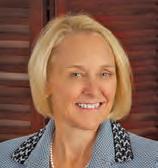
Susan Clayton Moore, J.D., is a financial advisor and wealth manager of Moore Wealth Management, Inc., with offices Montgomery and Alexander City, AL. Susan has over $150 million in assets (as of 9.1.24) under management through Kestra Financial and has been a financial planner for over 40 years. Contact Susan at 256.234.2761. Email contact is susan@moorewealthmanagement.com.
The opinions expressed in this commentary are those of the author and may not necessarily reflect those held by Kestra Investment Services, LLC or Kestra Advisory Services, LLC. This is for general information only and is not intended to provide specific investment advice or recommendations for any individual. It is suggested that you consult your financial professional, attorney or tax advisor regarding your individual situation. Securities offered through Kestra Investment Services, LLC (Kestra IS), member FINRA/SIPC. Investment Advisory Services offered through Kestra Advisory Services, LLC (Kestra AS), an affiliate of Kestra IS. Kestra IS or Kestra AS are not affiliated with Moore Wealth Management, Inc. https://www.kestrafinancial.com/disclosures



